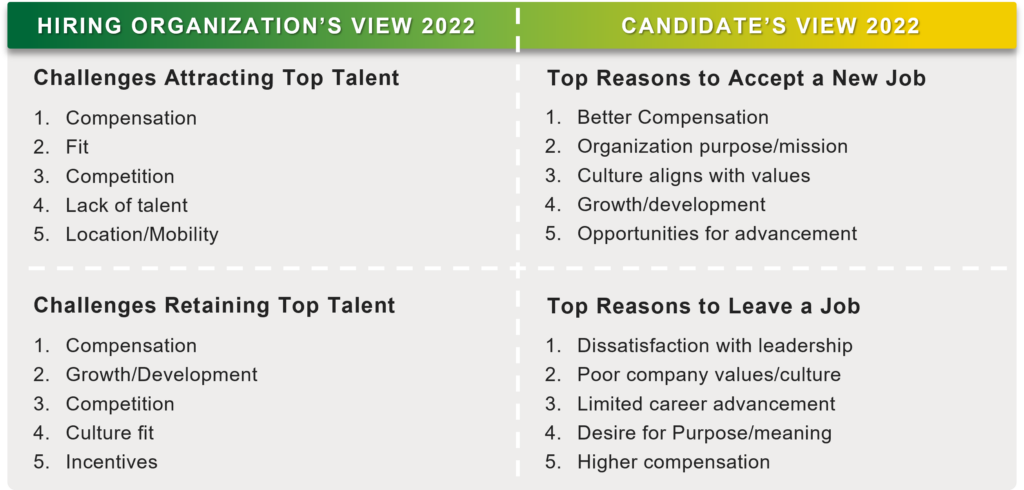Our conversations with more than 15,000 prospective candidates in 2022 validate that top leaders continue to prioritize their career and evaluate opportunities from a different lens.
Prospective candidates are looking to align with an organization that has a clear purpose and a role that resonates on a deeper level. Prospective candidates are asking tougher questions and observing how hiring teams are making decisions, communicating employee value, and describing opportunities for growth.
There is a corporate and candidate disconnect in today’s talent market. The gap between hiring organizations and candidate desires is widening specifically due to lingering effects of the pandemic. We continue to advise clients on evaluating the attractiveness of the organization and the position.

We also learn why leaders are leaving. Deloitte’s recent research found 70% of the surveyed C-suite executives are seriously considering quitting for a job that better supports their well-being. Organizations may be missing an opportunity to both attract and retain talent if they don’t address their own leadership, values, and culture.
The University of Melbourne professors, Leah Ruppanner, and David Bissel, and ARC Sr. Research Fellow, Brendan Churchill released a significant study that further validates what Principals at Kincannon & Reed are experiencing and recent research from the Association of Executive Search and Leadership Consultants (AESC). Following is that article:
You’ve probably heard about the “great resignation” which saw large numbers of people resigning from their jobs in the US in 2021 and 2022.
We didn’t see resignations over and above what is normal in Australia. However, we did see workers resisting the post-COVID return to the office.
To better understand these trends, we conducted a study of 1,400 employed Australians in 2022 to see how they were faring two years after the start of the pandemic.
And the answer is: not great.
The pandemic, particularly lockdowns, took a significant toll on the mental health of the Australian workforce. Although we’ve been desperately waiting for life to return to “normal”, pandemic-related disruptions remain.
Our previous research during the pandemic showed women and parents were particularly vulnerable. We found mothers stepped into the added childcare and housework driven by pandemic lockdowns. We discovered fathers also did more housework and child care over the first year of the pandemic.
The consequence of all of this added work was poorer mental health – worse sleep, less calm, more anxiety.
We also showed this intensified women’s economic precarity, leading to reduced contributions to superannuation and fear of jobs being lost without the skills to re-enter employment. Women are increasingly concentrated in industries such as nursing, childcare workers and primary school teachers, all of which were particularly impacted by the pandemic. Young prime-aged women were particularly impacted during the early period of the pandemic and lockdowns.
The pandemic was unforeseen, severe and detrimental to our working lives. Many Australia workplaces and workers continue to be impacted as the pandemic continues. Higher numbers of workers are taking sick leave, which may in part be driven by exhaustion and other COVID-related reasons.
Australian workers in our survey have some clear solutions. They found access to flexible work particularly valuable for their working lives. In our study, we found flexible workers had more energy for their work and a greater motivation to do their jobs. They reported more time to complete their tasks.
Around 40% of all flexible workers reported feeling more productive since the start of the pandemic, compared to around 30% of non-flexible workers.
And 75% of workers under the age of 54 reported that a lack of flexible work options in their workplace would motivate them to leave or look for another job.
Flexible work is working for many in the Australian workforce. Australian employers would do well to identify ways to expand its reach to a larger segment of the workforce or risk suppressed productivity and loss of their workers.
As we rush to return to pre-pandemic “normal”, our report identifies two critical points.
The Australian workforce is burnt-out and exhausted. We need to acknowledge the trauma of the pandemic is lingering and identify clear solutions to support this exhausted, fatigued, and overexerted workforce.
We must understand pre-pandemic ways of working didn’t work for many. It especially didn’t work for mothers. It didn’t work for caregivers. It didn’t work for people living with chronic illness. It didn’t work for groups vulnerable to discrimination at work. It didn’t work for people forced to commute long distances. So, going “back to normal” means continued disadvantage for these groups.
This means creating new ways of working, including flexible work, is essential to ensuring the Australian workforce has the energy for tomorrow and the next major challenge we will face.
University of Melbourne Contributing Authors:
Leah Ruppanner, Professor of Sociology and Founding Director of The Future of Work Lab, The University of Melbourne
Brendan Churchill, ARC Senior Research Fellow and Senior Lecturer in Sociology, The University of Melbourne
David Bissell, Professor of Human Geography, The University of Melbourne
Disclosure statement
Leah Ruppanner receives funding from the Australian Research Council.
Brendan Churchill receives funding from the Australian Research Council.
David Bissell receives funding from the Australian Research Council.
Partners
University of Melbourne provides funding as a founding partner of The Conversation AU.